Foreign Policy for New York City: Now Is The Time
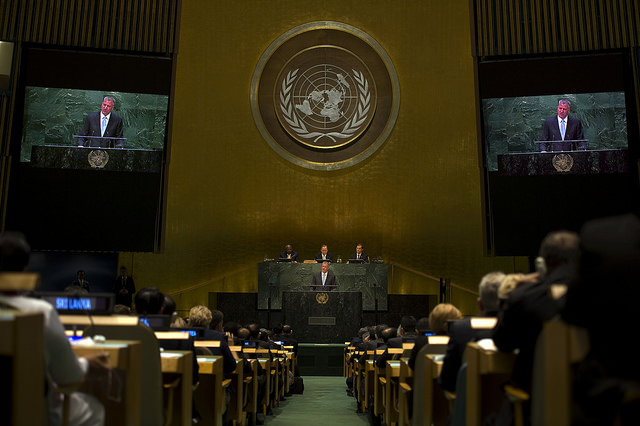
Mayor de Blasio at the U.N. in 2014 (photo: Rob Bennett/Mayor's Office)
What would it mean for a city to have a foreign policy? And specifically what would it mean for New York City to have a foreign policy? At first sight, this question might seem somewhat absurd, or at least contentious. It is, of course, the United States government that has a State Department, a Defense Department, and embassies all around the world, not New York City. Diplomacy and international affairs are the work of the sovereign, are they not? Why would New York need to, or even be able to, do the work that Washington is already doing?
In short, the key question really is: could New York City make use of or benefit from an autonomous “metropolitan foreign policy?”
To answer, and to research and develop the policies that we will need to act, we have established the Metropolitan Society for International Affairs. We are New York City’s foreign policy think tank, and over the coming years, we will be researching and publishing on the nature of the city’s global interests, proposing new policies and programs for city government, and working with civic and commercial organizations throughout the city to integrate these global interests into local action.
We plan to make the case to all New Yorkers that in an era where national and metropolitan interests are no longer likely to be reliably contiguous, we must take it upon ourselves to develop and establish the institutional and policy structures necessary to articulate and pursue our own metropolitan interests through our own capacity.
But given that New York City has prospered so greatly for so long without this kind of autonomy, and that our proposals represent a rather large divergence from the norm, it is reasonable to explain our thinking, and suggest the path ahead.
To say that New York City is importantly distinct from the rest of the United States and uniquely influential among global cities is not to say anything particularly revolutionary, and certainly does not need to be enumerated for New Yorkers themselves. And yet, along with this obvious uniqueness, New York remains quite definitively a unambiguously American city. For most of its history, the city, its people, and its government have resolved this duality by expressing its New York-ness locally and through its culture and society, and its American-ness out into the world through the institutions of the U.S. government.
However, it is becoming increasingly apparent that this solution will not continue to hold in the future as effectively as it has in the past. And while the roots of this disjuncture go back many years, recent actions of the Trump admin have made this tension far more obvious than before.
Recent federal policy decisions on climate change and immigration, to name the most prominent two, illustrate the depth of the divergence between D.C. foreign policy interests, and those of New Yorkers. Nor is the issue one of partisan politics. The D.C. foreign policy consensus advanced by the last Democratic administration saw the U.S. take a far more hawkish line on China and Russia relations than New York City interests, favoring financial and cultural exchange, might have chosen to pursue. Federal and metropolitan interests often overlap, but are not perfectly coterminous.
However, at present, the New York City government does not possess an institutional apparatus, a diplomatically-minded political class, or a cultivated sense of its international political interests among New Yorkers to act on these divergences in a systematic way.
We began the Metropolitan Society for International Affairs because we think New York City deserves all three of these things. We will research, analyze, and articulate a metropolitan foreign policy for New York City. We will work with the city government to develop a practical strategy to implement it. And we will engage with New Yorkers from all spheres of society to build a political consensus around this bold new direction in city politics.
***
Peter Marino is Executive Director and Research Director at the Metropolitan Society for International Affairs, and Senior Engineer at the Global Narratives Project. He is a fourth-generation New Yorker. On Twitter @nycitywonk and @themetsociety.
***
Have an op-ed idea or submission for Gotham Gazette? Email This email address is being protected from spambots. You need JavaScript enabled to view it.
Protecting Immigrant Workers in the City of Immigrants
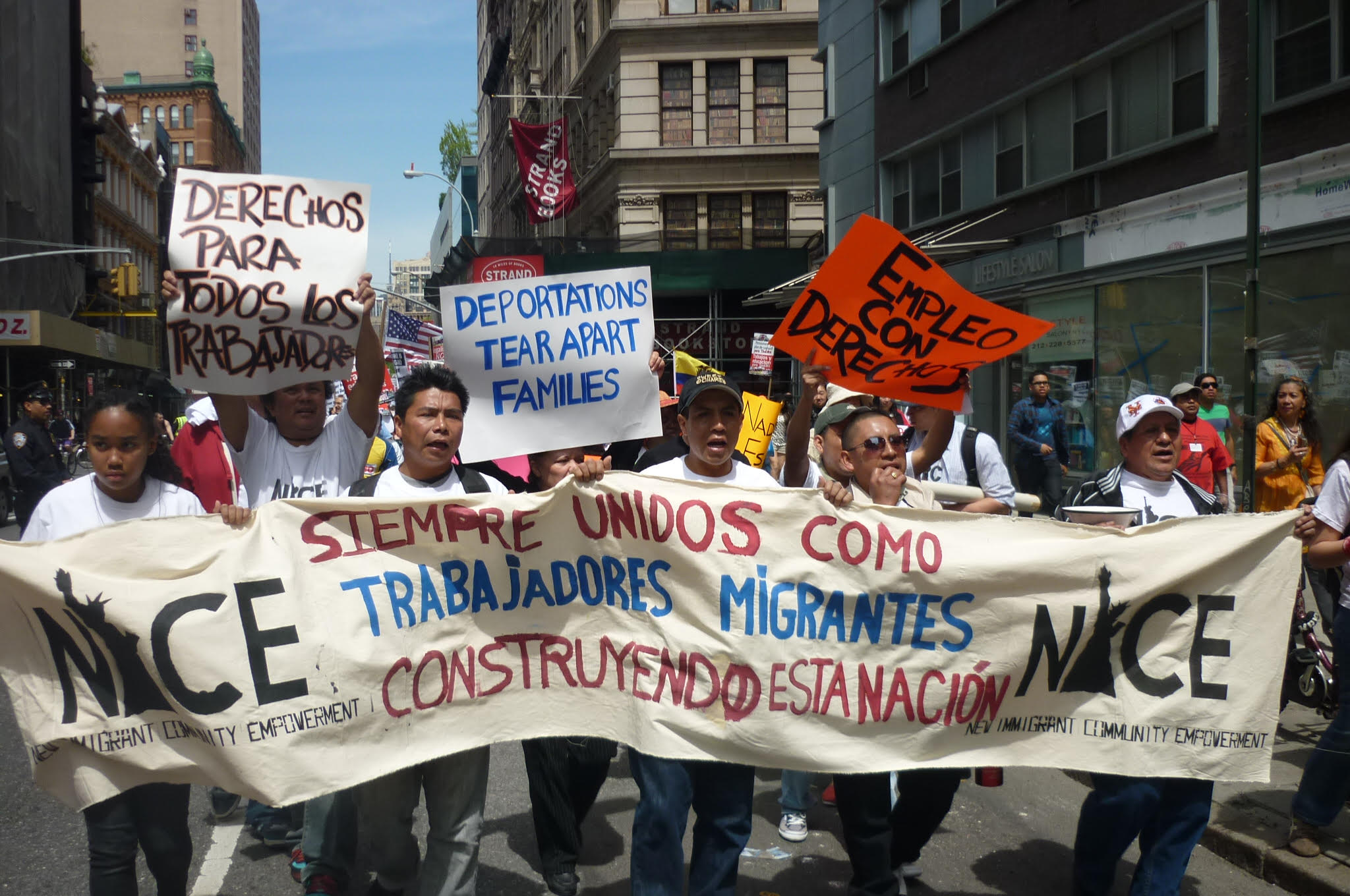
(photo: NICE)
Just last week, Juan Chonilla and another still unidentified worker died from construction accidents. These men were important members of our immigrant community. As one of the members of New Immigrant Community Empowerment (NICE), one of these men was family. These tragic deaths and severe injuries of multiple construction workers last week, on sites with safety violations, underscore the urgency for New York City to enact legislation that meets the needs of all workers.
The City Council is currently considering a bill, Intro. 1447-C, that would mandate increased safety training standards, and the Council has the opportunity to ensure that we don’t lose sight of the fact that we are talking about safety - and the very lives - of the city’s immigrant workers.
On any given day in New York City, there are thousands of immigrant construction workers seeking increased access to trainings for higher safety and health standards in their workplaces. These workers live under precarious and dangerous conditions every day due to their immigration status and work conditions. There are countless examples of bad-acting employers who use immigration status as a threat to workers, denying their rights to health, safety, and fair wages.
Organizations like NICE, a worker center and member of the New York Immigration Coalition, are often the only support these workers have. We are able to help workers get critical services such as health and safety trainings in their native language and help address other labor issues they face. Many of these workers come to us after they have already started working, only to discover health and safety violations at their worksites after receiving training.
The story of one of NICE’s members, Antonio, is the embodiment of the unique struggle of our city’s immigrant construction workers. Antonio and his two co-workers noticed a crack in the reinforcement of an excavation and informed their supervisor of the danger, as they had been trained to do. Their supervisor instructed them to begin work, and within minutes of beginning, the wall collapsed, trapping Antonio and another worker under crushing dirt and concrete. While the employer was busy locking the entrance to the site so no one could see, Antonio’s colleagues called 911 and recorded the incident on video. Antonio’s co-workers were subsequently fired for this act of solidarity and humanity.
Antonio’s story shows that construction workers are often the victims of blatantly negligent employers, who value their production over workers’ well-being. Workers like Antonio are not only deprived of safety on their jobs, but also of real protections and compensation after an accident. Their bad-acting employers face weak penalties and are able to continue construction projects that will inevitably put more workers at risk of injury or death.
Immigrant workers come to New York City with aspirations to support their families and build a better future, only to find that they are the target of unscrupulous employers, offered lower-wage work, and put in abusive and dangerous working conditions. If New York City is truly committed to its immigrant population, it cannot let these conditions continue on its watch. When workers like Antonio or Juan Chonillo are hurt or killed on the job, it is far from incidental. Accidents can be prevented when employers respect and adhere to the labor rights of their workers. We know from our experience that when an employer ignores health and safety laws, they will likely violate other labor laws; studies have shown this correlation.
This week, as the City Council considers Intro. 1447, we call on it to ensure that immigrant workers are able to obtain adequate safety training required by the bill. We furthermore call on the Council to develop stricter enforcement for safety protocols at constructions sites in the City in the future. The health, well-being and very lives of our members, our families, our neighbors are currently at stake. We need to make sure we are listening to their voices to develop solutions that protect them.
***
Manuel Castro is executive director of the New Immigrant Community Empowerment (NICE). On Twitter @NICE4Workers.
***
Have an op-ed idea or submission for Gotham Gazette? Email This email address is being protected from spambots. You need JavaScript enabled to view it.
Support, Not Trouble, for a School Successfully Teaching Students with Disabilities

Opportunity Charter School leader Leonard Goldberg, middle, the author
A new report from the city's Comptroller showed once again that the City is unable to fulfill its responsibility to provide the necessary services to students with disabilities, failing to track $84 million allocated for disabled student services. Worse still, these findings come on the heels of the Public Advocate's report that revealed a troubling trend whereby the city offers parents vouchers instead of the necessary, required services for children with special needs. Troubling, but not surprising.
It’s no secret that the city’s public schools are not designed or equipped to properly serve the individual needs of students with disabilities, particularly those in low-income communities. In fact, while roughly half of all vouchers issued citywide go unused, this rate climbs dramatically in lower-income communities. District 8 in the Bronx, for example, has the highest rate of vouchers going unused at 91 percent.
This is why so many Bronx parents turn to Opportunity Charter School (OCS), a Harlem-based charter school that disproportionately serves children with special needs from communities of color. At OCS, we have been providing wraparound services since our founding in 2004, and focus on providing comprehensive clinical services to students and their families.
The majority of our students live in the Bronx, making the commute every morning because they can’t find the support they need in traditional public schools. And in spite of this, the city’s Department of Education has tried relentlessly to close our middle school, even after a Manhattan Supreme Court judge cautioned that the DOE would be wise to take a closer look at how to better evaluate a school as unique as OCS.
The trouble is there’s a gap between these schools in theory and in practice.
The students, who enter our middle school after years in the public system, are among the lowest performing in all of New York City, and well over 60 percent have a moderate to severe learning disability. These are the students who benefit most from the extra support OCS provides, and the same students that the city has previously failed to help.
At OCS, we work hard to help these students catch up, develop critical life skills and prepare for post-secondary success. Our individualized approach to learning pays off. In fact, this year, 86 percent of OCS students graduated on time, including 82 percent of students with disabilities. But the city, which is responsible for holding the 51 charter schools it authorizes accountable and renewing their charters, relies on a flawed system to make these judgements. The city bases decisions largely on the percentage of students in each grade that achieve “proficiency” on state tests, without acknowledging the makeup of the student body or how much progress individual students are making over time.
Meanwhile, the tests themselves are not designed to measure achievement among students with disabilities. Even DOE Chancellor Carmen Fariña acknowledged as much, going as far as to say that students with disabilities are ‘never [going to] get to a certain level on this kind of test’ and would consider opting out her own child if she were the mother of a student with a disability. This accountability system advantages students and schools with a history of academic success; bolstering charters that curate their student bodies and punishing those that take in struggling students. In other words, the current system is designed to enforce the status quo.
Each student with an IEP is different. Some have relatively minor disabilities, such as a speech impediment, but others face more significant obstacles, such as a severe learning disability. At our school, we don’t take a one-size-fits-all approach to teaching, and neither should the city.
Better alternatives are available. For example, the State Education Department, as well as other state authorizers have created systems tailored to evaluate schools that focus solely on serving at-risk student populations. Authorizers can allow charter schools this flexibility in measurement and it is important that they use this function properly. The DOE, despite its rhetoric, chooses not to apply this sensible approach.
If the city really wants to help students with disabilities, its leaders are going to have to rethink their entire approach, from the supports they provide to measuring growth. It’s past time for the New York City DOE to concentrate its efforts on supporting the city’s most vulnerable children and getting them the help they need, rather than unfairly targeting the institutions that make these kids a priority.
***
Leonard Goldberg is the Founder and Head of School at Opportunity Charter School.
***
Have an op-ed idea or submission for Gotham Gazette? Email This email address is being protected from spambots. You need JavaScript enabled to view it.
Note: this column has been updated with more recent data than originally published.
Planned Parenthood of NYC Joins Call to Remove Racist Statue
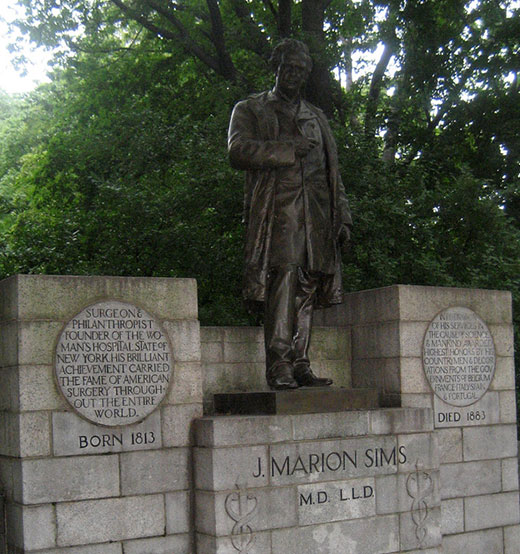
J. Marion Sims statue (photo via Wally Gobetz)
When images of white supremacists taking the streets in Charlottesville first surfaced, thousands of New Yorkers participated in rallies to condemn the hateful actions and rhetoric of white supremacist groups. The protests were powerful affirmations of our city’s stance against racism and hatred.
But even though New York City is seen as a progressive place, we must not let this reputation blindside us. The history of racism isn’t particular to Charlottesville – New York must recognize white supremacy in our own backyard and we must take steps to upend it.
For years, activist groups around New York City have been doing just that by calling for the removal of a statue of Dr. J. Marion Sims, who repeatedly performed surgical experiments on enslaved black women in the 19th century without their consent and without anesthesia. According to Sims, “black women don’t feel pain.”
Recently, Black Youth Project 100 (BYP 100) held a powerful protest in Central Park calling for the statue to be removed. Planned Parenthood of New York City joined City Council Speaker Melissa Mark-Viverito and other elected officials and partners at a rally calling for the removal of this statue. East Harlem Preservation has also been calling for this statue to be removed for a decade.
PPNYC strongly condemns the statue of Dr. Sims because it sanctions racism, hate, and abuse of black women. We stand with the many groups calling for its immediate removal.
This call to action goes beyond merely removing a statue or symbol. We need to recognize and call out white supremacy as a fundamental and systemic problem that fuels racial and economic inequality and reproductive oppression.
America has a long history of controlling and threatening the safety and body control of people of color. White supremacy affects the people who come to Planned Parenthood for care and their ability to determine their own destiny. We cannot lose sight of that as we continue to fight to expand and improve reproductive health care for all.
Black women are still three-and-a-half times more likely to die in childbirth than white women in The United States. Laws that block access to abortion and contraception disproportionately impact low-income communities, including immigrants. Women of color, who are more likely to rely on Medicaid to receive health care, risk losing access to life-saving services like cancer screenings, STD testing and treatment, and more, because of Congress’ shameless attempts to defund Planned Parenthood.
At PPNYC, we know that a statue that represents violence and hatred and a lack of medical care has no place in our city. We also know that our work will continue beyond the statue’s removal. PPNYC is more committed than ever to delivering compassionate care, and to building a city where no one has to live in fear of exclusion, harassment, or violence.
At PPNYC, we welcome people of all races, backgrounds, ages, incomes, and immigration statuses to our doors for high-quality health care. We will never turn away anyone seeking health care – no matter what.
Not just because our patients’ lives are at stake, but because that is our mission – to ensure that all New Yorkers can access the care they need to lead safe and empowering lives.
Planned Parenthood of New York City stands with BYP 100, East Harlem Preservation, and other groups and activists speaking out against racism and white supremacy. As the injustice of racism persists, none of us can be silent. For the sake of our city and our country, all of us must take a stand.
***
Christina Chang is Vice President of Public Affairs at Planned Parenthood of New York City.
***
Have an op-ed idea or submission for Gotham Gazette? Email This email address is being protected from spambots. You need JavaScript enabled to view it.
'Placeholder' Must Temporarily Take Squadron's Seat
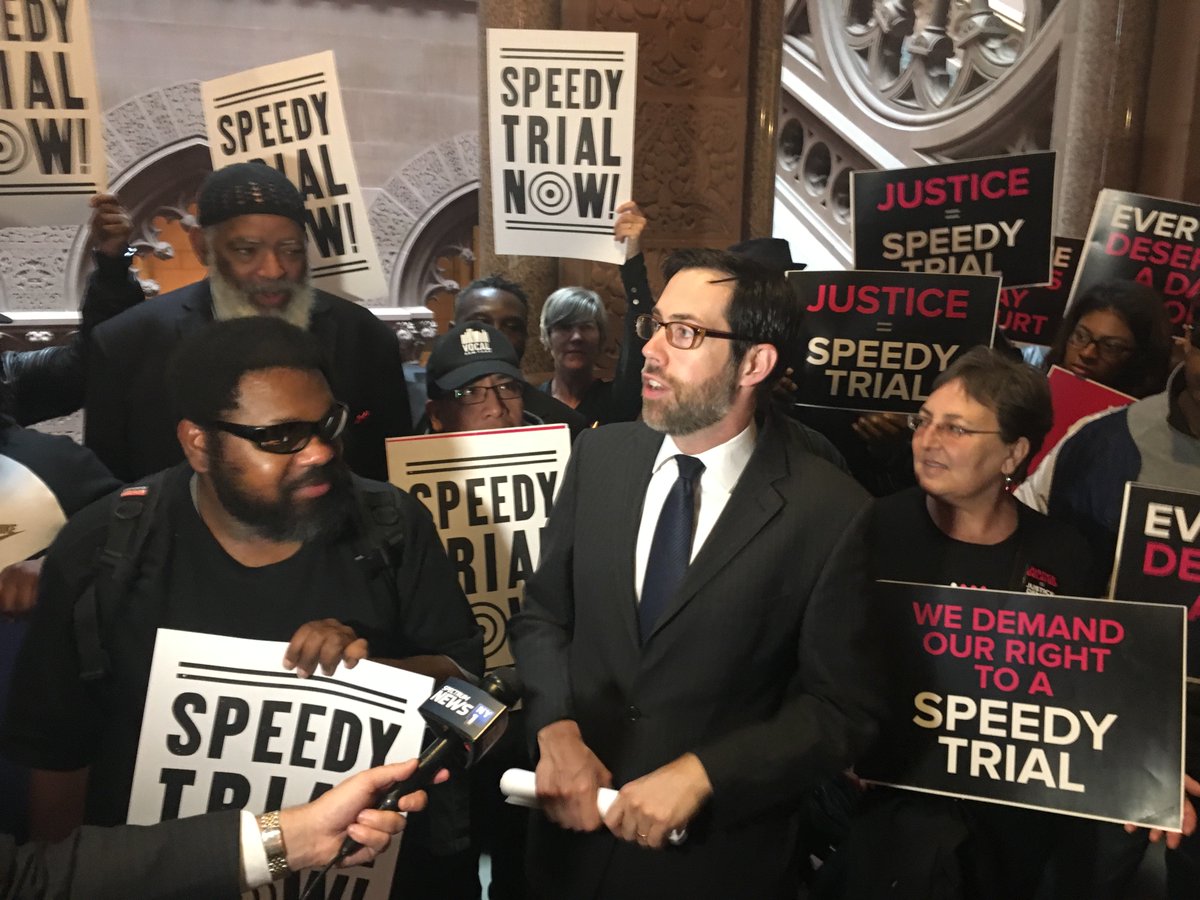
Former State Senator Daniel Squadrion (@DanielSquadron)
The unexpected resignation of New York State Senator Daniel Squadron threatens to diminish the fundamental democratic right of the people to choose our representatives. What is needed now is a temporary “placeholder” who pledges to protect that threatened right by only serving out the rest of the current term and allowing a regular, open election to take place next year.
By way of background, Sen. Squadron was first elected nearly a decade ago and represented the 26th state Senate district, which includes the Brooklyn waterfront and lower Manhattan. He resigned in mid-August to undertake an initiative with Columbia University professor Jeffrey Sachs to help Democrats win seats in state legislatures nationwide. While Sen. Squadron left elected office to pursue an admirable goal, the timing of his decision has led to the immediate problem of subverting democracy in our city.
That’s because the window to hold a special primary election already passed by the time he stepped down. As a result, party bosses in Brooklyn and Manhattan now have the power to hand-select the Democratic nominee for a special general election, someone who would inevitably win in November in the heavily Democratic district. With the power of incumbency, the designee would likely win reelection over and over again, beginning with 2018’s regularly scheduled state legislative elections.
The Kings County (Brooklyn) and New York County (Manhattan) Democratic committees must explicitly reject this undemocratic result. Instead, members of both county committees should rally behind a consensus “placeholder” candidate who pledges not to run for reelection in 2018.
The placeholder candidate option would allow the constituents of the 26th Senate district to have a full, robust discussion during next year’s primary race about the values and capabilities of those hoping to fill the seat. Informed choice is the key to meaningful elections.
An ideal placeholder would be an elder statesperson with experience in public service, preferably some in Albany. Armed with that wisdom, he or she could make the most of a truncated term.
Some may argue that finding a politician willing only to serve for such a short period of time would prove too challenging. They may even ask how we can be assured that the placeholder would keep his or her word and not run again in 2018.
First, as a practical matter, a placeholder who broke his or her word and ran for reelection in 2018 would be taking a huge gamble in so cavalierly lying to constituents. But more importantly, the placeholder alternative is the only solution that would restore true democratic choice to the people. It’s simply the best shot we have.
It was heartening to see Brooklyn Democratic boss Frank Seddio express support for the notion of a placeholder senator.
Responsible government begins at home. We, the citizens of New York City and New York State, must demand a government accountable to the people. That means, at a minimum, insisting on a thorough and complete election process for choosing our representatives.
What we need now are leaders willing to make sure that process takes place.
***
Steve Wagner is a Brooklyn-based activist and personal injury trial lawyer. He is a member of Independent Neighborhood Democrats and a steering committee member of Indivisible Nation BK. He blogs at brooklynresists.nyc.
***
Have an op-ed idea or submission for Gotham Gazette? Email This email address is being protected from spambots. You need JavaScript enabled to view it.
Children Lose in Faulty Charter School Accounting
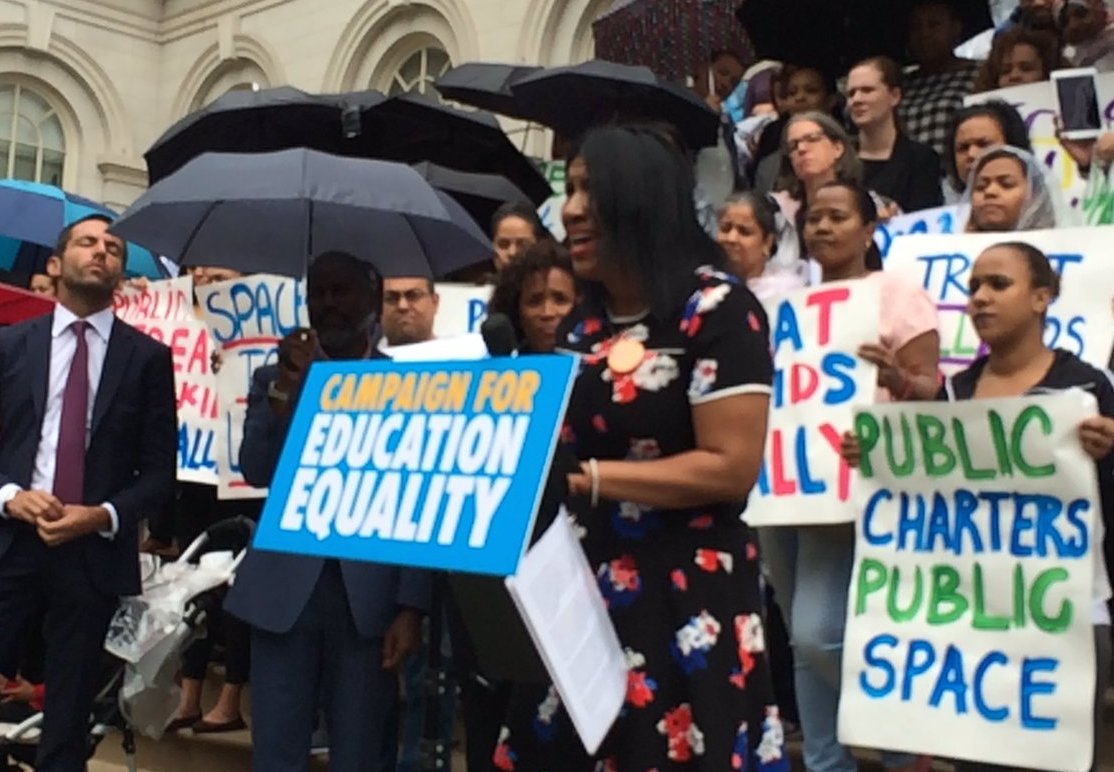
A charter school rally (photo: @SuccessAcademy)
Questions: How do you turn a 25 percent graduation rate into a misleading claim of 100 percent success? When does a school’s 30 percent proficiency rate on an 8th grade reading test translate into the assertion that nearly half of the students passed?
Answer: when charter schools do their own accounting, and authorizers allow them to paper over the fact that huge percentages of the children who start in charter schools get driven or eased out.
Charters claim that they serve the same children as city public schools, but the truth is that they enroll and keep half the percentage of English Language Learners, dramatically fewer special education students, including those needing the highest level of intervention, and far fewer children who are homeless or in temporary housing.
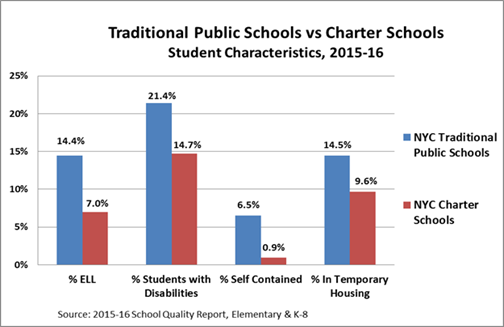
Not content with starting out with more favorable demographics, many charters then rely on student attrition, boosted by draconian discipline strategies, to keep their academic numbers up. In New York City, charters enroll 8% of the students but account for 45% of the suspensions.
Suspensions and pressure on students who struggle academically help charter schools force or ease out students with learning difficulties. And unlike regular public schools, charters often leave empty seats vacant.
As one charter organization -- Democracy Builders -- noted, when schools refuse to "backfill" or replace students who leave, the result is charters hyping their results (“artificially inflating perceived performance” in Democracy Builder’s words).
Here’s how it works.
At Success Academy Harlem 1, 73 students began first grade in 2007. By now this class has dwindled to 18 students as they reached the 11th grade. Assuming all 18 stay this year and graduate, Success Academy will no doubt claim a graduation rate of 100 percent. But in fact there are only 18 “survivors” of the original 73; even if all 18 graduate, the school should only take credit for a grad rate of 25 percent of the original cohort.
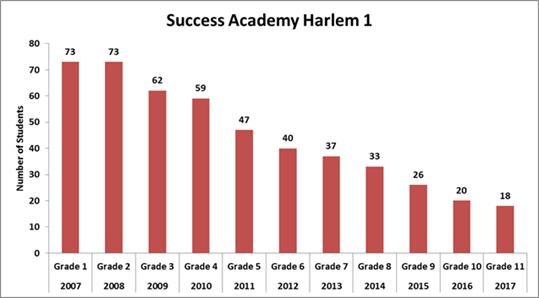
The same logic can be applied to test score claims. Teaching Firms of America Professional Prep Charter School in Brooklyn claims that nearly half -- 47 percent -- of its sixth graders were proficient on the most recent state reading test. But that sixth grade class had only 36 students, far short of the 57 students who were in that class in third grade.
So counting the vanished children, only 30 percent of the original cohort actually scored proficient on the 2017 reading test, a rate well below the 40 percent passing rate average for all public schools.
None of these facts will stop charter propagandists from repeating misleading claims about their schools’ “success.” But charter authorizers, especially the SUNY Charter Schools Committee, need to be considering these issues as charters come up for re-authorization.
The committee has recently taken a tougher line against some charters, criticizing the chair of the board of Success Academy, Dan Loeb, for his indefensible statements comparing the actions of State Senator Andrea Stewart-Cousins and teachers unions with the KKK.
But the committee's recent proposal -- to permit some charter schools to drastically reduce the amount of preparation teachers must undergo in order to be certified – is an ill-considered favor for a sector that has proven itself not only incapable of honest accounting, but also unable to retain a qualified workforce.
If charter schools are to perform their original mission -- to act as laboratories of innovation -- it is up to authorizers to ensure that charter schools take seriously their obligation to educate all kinds of children, and to give New York parents a realistic view of both their successes and their failures.
***
Michael Mulgrew is the President of the United Federation of Teachers. On Twitter @UFT.
***
Have an op-ed idea or submission for Gotham Gazette? Email This email address is being protected from spambots. You need JavaScript enabled to view it.
Note: this opinion column has been corrected to reflect that one organization cited is Democracy Builders, not Democracy Prep as originally stated.
The Threat Lurking on Primary Day
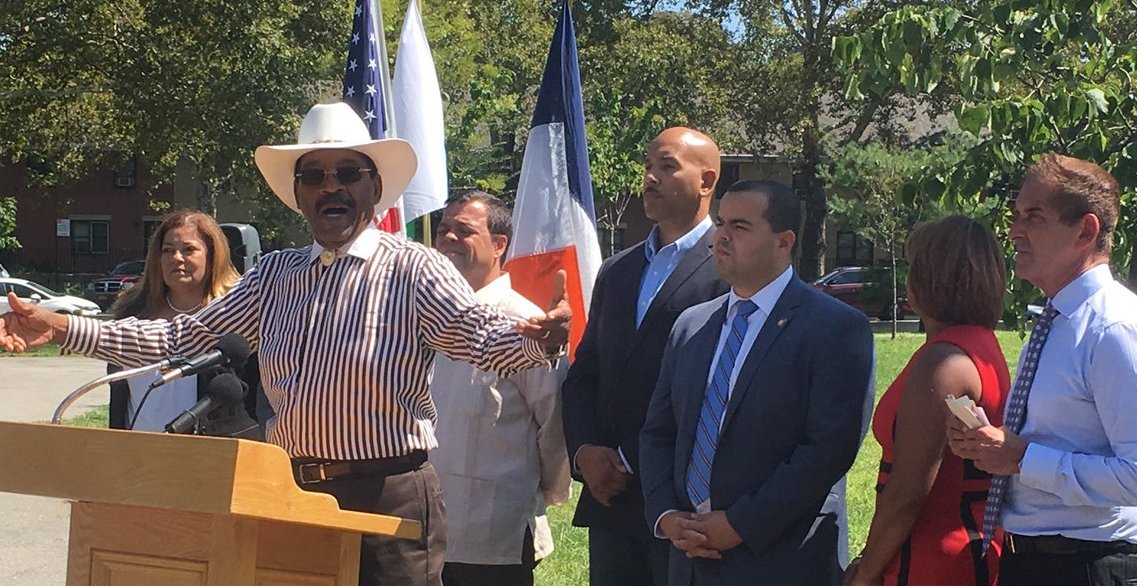
State Senator and City Council candidate Ruben Diaz Sr. (photo: @RevRubenDiaz)
The New York City Council is under threat. There is a force exerting immense pressure to dangerously influence the session beginning in January. That threat goes by one name: Albany. And it is bearing down on the city this week.
We need to take stock of what is happening, and vote accordingly on Tuesday, September 12, or the 2018 City Council class will be far less progressive than the current.
What do I mean by the Albany threat? State legislators who represent people from New York City who are eager to get out of working in Albany and are running for the City Council. They have experience in campaigns with far fewer restrictions to keep them accountable to voters. Their experience as policy-makers is one where they are completely constrained by the leaders at the top and far less serious about the work of an elected official with legislative, oversight, and constituent service responsibilities.
These Assembly members and Senators have mostly accepted an unethical and unacceptable state government as it is, sought to bring some funding back to their districts, and cast blame around for the lack of beneficial policy results. Seeking easier commutes and a substantial pay raise, several state legislators are seeking seats in the City Council this year, with Tuesday’s primary elections set to determine the overall winners and losers given the city’s Democratic advantage. In order to run this year, these legislators don’t have to risk their seats, and with the power of name recognition and fundraising that accompanies being an elected official already, they have distinct advantages, no matter how good their opponents may be.
The worst case scenario is an eventual takeover, given the handful of potential migrants this year and the floodgates that could open in 2021, when many more Council seats will be open due to term limits. Voters must take a stand this year. And while it should be done on a candidate by candidate basis, overall, the threat of Albany must be beat back.
A quick survey of some of the contested Council seats confirms this Albany threat is real. In Brooklyn, City Council Member Carlos Menchaca is threatened by Assemblymember Felix Ortiz, whose main accusation is that Menchaca isn’t good at constituent services. In Queens, two Albany people are fighting for City Council Member Ferraras-Copeland’s seat, and the progressive city is quivering that a former Albany gargoyle, Hiram Monserrate, will be defeated by a current state legislator who is hopefully not anywhere near as bad.
In both City Council District 13 in the Bronx and District 8, which includes parts of East Harlem and the South Bronx, the competition pits a male Assembly member against a strong female candidate with positive community experience and a bright future.
In the Bronx, State Senator and Reverend Ruben Diaz Sr. announced that he is entitled to run for the City Council and that he eschews calls for separating religious and government work because, “I am the Church and the State.” He’s sucked up all the air in the room with a slew of major endorsement and his name recognition, and he’ll likely shut the door of opportunity on qualified candidates seeking their first elected office.
Also worth noting, then-State Senator Bill Perkins already nabbed the Harlem City Council seat in a special election earlier this year, and will likely ride the incumbency power to a victory this fall, despite other candidates ready to serve.
Not all of these Albany legislators are terrible as individuals. Some state legislators go to the capital to fight for and deliver change. But voters should wonder why each one attempting to leave is ready to jump ship and carefully consider the options on the ballot.
Is this current exodus from Albany representative of a strategic effort to tamp down the policy-driven New York City Council? That Council has moved a great deal of progressive policy over the last four years. Continuing in that direction is under threat.
Do these legislators just want a pay raise? It’s a question worth asking.
Most Albany legislators’ City Council campaigns echo themes of “I provide good constituent services so you should vote for me,” regardless of whether they have a record to stand on. They prioritize their constituent services to ingratiate themselves to their voters without actively seeking out ways to fix broken systems. While the Council’s current members are full of imperfections, the last four years have been full of real efforts to make government better for New Yorkers.
“Elections have consequences” was one of the themes that finally landed after the 2016 presidential. The consequences in New York City of the Albany influx will be many—number one, as new members they could block the victory of a potential progressive Speaker of the Council, which could then very easily halt real and important policy changes. They could defer to Albany’s typical priorities of promoting the interests of real estate developers and coming up with excuses for failing to fix healthcare, support immigrants, and achieve ethics reform.
If Albany sees a way in this year, we can be assured that in four years when most of the Council races will not have incumbents, many more state legislators will attempt to get out of Albany, intensifying this threat.
Elections do indeed have consequences. One could be a lot more Albany status-quo do-nothings elected in New York City; another could be a risk-taking, people-oriented Council for the next four years.
***
Richard Semegram is a tenant attorney in Manhattan. On Twitter @richagram.
***
Have an op-ed idea or submission for Gotham Gazette? Email This email address is being protected from spambots. You need JavaScript enabled to view it.
Dig Just Once to Tackle Noise Pollution and Get More Done
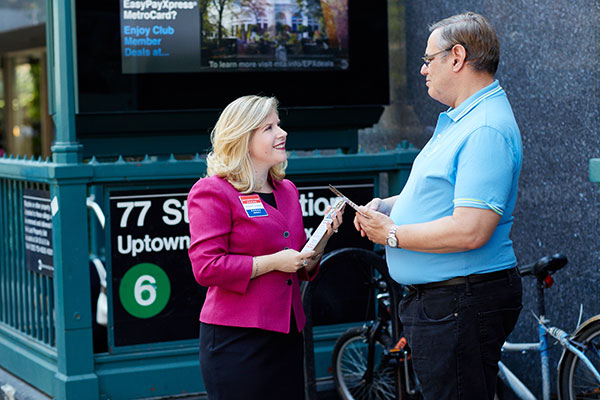
Vanessa Aronson, left, is the author (photo: Aronson campaign)
Sometimes it sounds like machine gun fire. Sometimes like the wail of a banshee. Sometimes like a wheezing dragon. And sometimes like all three at the same time.
I’m talking about the jackhammers, construction equipment and crews digging up your street for power cables, sewer work, and high-speed internet conduits. It’s an unfortunate part of New York City living. But it doesn’t have to be that way, especially for broadband fiber optics.
New York City must deal with its noise pollution, and should quickly adopt a Dig Once policy, which would lower the cost of broadband expansion by doing two things:
One, requiring city utilities to coordinate digging schedules so that they accomplish what needs to be done efficiently. And two, Installing fiber optic conduit when the ground is dug up for other projects.
By installing fiber conduit with enough space for additional networks, we can limit the need for new construction, meaning digging new holes and trenches every time new fiber is required. That way the cost of that construction is amortized over all projects that later use the conduit. This not only reduces costs but also minimizes hazards and headaches for drivers, pedestrians, business owners, visitors, and residents. All while adding less than one percent to the total cost of the construction.
And Dig Once works.
The Dig Once policy is already in place statewide in Arizona, Minnesota, and Utah, as well as in Boston and San Francisco.
Simply put, this policy can save money by minimizing the amount of digging and noise, and reduce inconvenience when installing necessary conduits and cables. Successfully implementing a Dig Once policy is based on leveraging the “rights of way” that are owned and managed by many different utilities and communications companies.
At a state level Dig Once broadens the authority of the state’s Department of Transportation to include the transportation of information. This allows the agency to coordinate the installation of multi-user conduits in state highways.
At a city level, Boston’s Dig Once is a “joint build” policy that requires all telecom companies to install their cable in shared underground conduits on a shared-cost basis. This policy also designates a “lead company” that is tasked with coordinating efforts between all involved in the installation process, planning and implementing the installation.
San Francisco’s Dig Once Specification has lowered the cost of conduit installation from $128,000 per street mile for the first installation (including excavation) to $71,000 for the second.
Although there is no federally mandated policy, U.S. Executive Order 13616 directed the U.S. Department of Transportation to review Dig Once requirements and to work with state and local governments in the development and implementation of sensible construction policies including Dig Once.
If the U.S. adopts a Dig Once policy, construction workers would install conduits just about any time they excavate for new roads and dig up your sidewalk. But we’re New Yorkers. We shouldn’t have to wait for Washington to save us money and time, and from the assault of jackhammers. We can -- and should -- Dig Once now.
***
Vanessa Aronson is a Democratic candidate for City Council in District 4. On Twitter @VanessaAronson.
***
Have an op-ed idea or submission for Gotham Gazette? Email This email address is being protected from spambots. You need JavaScript enabled to view it.
Congestion Pricing Won't Solve New York's Transportation Woes
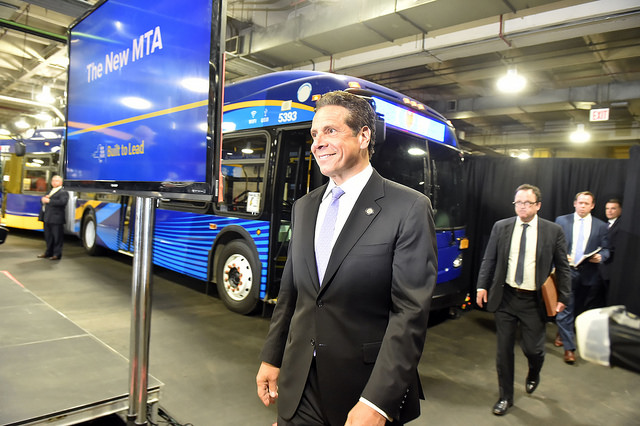
Gov. Cuomo and a bus (photo: Kevin P. Coughlin/Governor's Office)
Governor Andrew Cuomo’s recent vague interest in congestion pricing as a solution to problems at the MTA may give new life to one of former Mayor Michael Bloomberg’s key policy goals, but absent transportation improvements officials could be making now, pricing will not save our subways. We cannot let them off the hook in search of the perceived silver bullet of congestion pricing.
The transportation community has been salivating over Cuomo’s statement that “congestion pricing is an idea whose time has come,” hoping that the governor will be able to convince the state to put a cordon toll around Manhattan south of 60th Street. Such a cordon toll, which would charge drivers entering the area on a daily or per trip basis, is reflective of similar policies elsewhere, particularly London, which implemented a congestion charge in the central city district in February 2003. Yet commenters and policy nerds this side of the Atlantic have missed the real substance of London’s improvements, and in doing so, they are giving our elected officials a pass on work they should be doing right now, regardless of the status of the pricing proposal.
What today’s transportation advocates are missing is that the key ingredient to London’s success was not its charge but its buses.
Beginning in 1993, ridership on London’s double-deckers increased annually, and was up 37% by the time the charge was implemented in 2003. In 2004, London’s buses carried more passengers than the New York City subway. While those ridership numbers are impressive on their own, what they signify is an overall shift away from cars to buses, bikes, and walking. London’s congestion charge was envisioned as a specifically anti-car policy, designed to make it easier for buses and taxis to traverse the city center.
When New York City congestion pricing advocates see London’s roads covered in bus lanes, they may imagine that the charge enabled such a shift, freeing up road space to then be taken over by buses and bikes. In fact, nearly all of London’s 180 miles of bus lanes were implemented before the congestion charge, in that era of increasing ridership between 1993 and 2003. The lanes and other improvements insulated London’s buses from congestion enough, even before the charge, to improve rider experience and reduce excess waiting time at stops. Combined with a lower fare on buses compared to the tube, the operational improvements led to increased ridership and declining car use before the charge policy was even developed.
New York’s bus system pales in comparison.
The city currently has just over 50 miles of bus lanes. While buses have priority at most intersections in London, such priority only exists in New York on four Select Bus Service routes. As congestion has risen, bus ridership has fallen as bus speeds have slowed to a level barely faster than walking.
Nowhere is the lack of bus priority more egregious than on the East River bridges, the very place tolls would be implemented. When Mayor Bloomberg signed the initial contract with the USDOT for his congestion pricing proposal, East River bus lanes were the only specific bus improvement named. When the deal fell through, the East River bus lanes plan mostly died.
There are high-occupancy vehicle (HOV) lanes, used by both buses and cars with two or more occupants, in the tunnels and in the mornings on the Queensborough and Manhattan Bridges. The tunnel HOV lanes serve the express buses, the second-most heavily subsidized way to travel in the city after the commuter rail. Currently, the Queensborough bridge carries three local routes and 18 express routes. There are no buses that cross the Manhattan Bridge and benefit from the HOV lane.
For New York’s system to match London’s status before the charge was implemented, we need not only priority for buses on the roads but also more local buses into Manhattan. Based on London’s experience, getting drivers out of their cars requires a double shift.
First, some subway riders shift to buses for shorter trips; then drivers, who generally take longer trips, switch to the newly opened subway space. New York’s bus system largely lacks bus routes to accommodate people switching from the subway to bus. Currently, only a single local bus goes from Brooklyn to Manhattan, the B39, which runs only between the Williamsburg Bridge Terminal and Delancey Street, and comes every half hour. Unsurprisingly, it has the lowest ridership in the bus system. Without more direct bus connections to Manhattan, New York severely limits the bus system’s ability to provide a subway relief valve.
To be clear, there are activists calling for New York to focus on its bus network, but the centrality of the bus network to the functioning of the whole system is not fully depicted. The Bus Turnaround Campaign, comprised of the Riders Alliance, TransitCenter, TriState Transportation Campaign, and the Straphangers Campaign, have called for bus improvements for the sake of riders, but not as a way of improving transportation in the city as a whole, though their recommendations are based in part on London’s improvements, including increased bus priority, less circuitous routing, and improved fare payment.
What is frustrating is that many advocates believe that they have to support the pricing proposal in order to achieve bus system improvements, and that others feel as though they don’t need to advocate as hard for buses because the charging regime will magically improve the buses. The reality is that absent good alternatives to switch to, any charge that is politically feasible (maybe no more than the cost of a subway fare, well short of what is proposed in the most thorough proposal to-date, the Move New York plan) will be ineffective at reducing congestion and thus at improving the buses. London’s temporary drop in congestion following the charge was made possible by the bevy of available bus seats. While New York has available bus seats, they are not yet good alternatives. If they were, we would have seen bus ridership increase during this especially difficult subway summer congestion pricing is supposed to fix, and we didn’t.
If New York wants to seriously improve the transportation system, it needs an all-out campaign on the buses, one with the same level of media attention given to a single Cuomo quote on congestion pricing. Because so much of the bus system is about how we prioritize our roads, this is a goal that a city mayor can actually make a significant dent in without the governor, the kind of transportation improvement our mayor enjoys. So rather than wait for Governor Cuomo to save us via a pricing system that won’t work in our current system, let’s appoint a congestion czar and get serious about a transportation system that provides affordable access for all.
***
Rosalie Ray is a PhD student in Urban Planning at Columbia University. Her research focuses on London's bus improvements in the 1990s and early 2000s.
***
Have an op-ed idea or submission for Gotham Gazette? Email This email address is being protected from spambots. You need JavaScript enabled to view it.
Don’t Endanger Minority Jobs in Name of Construction Safety
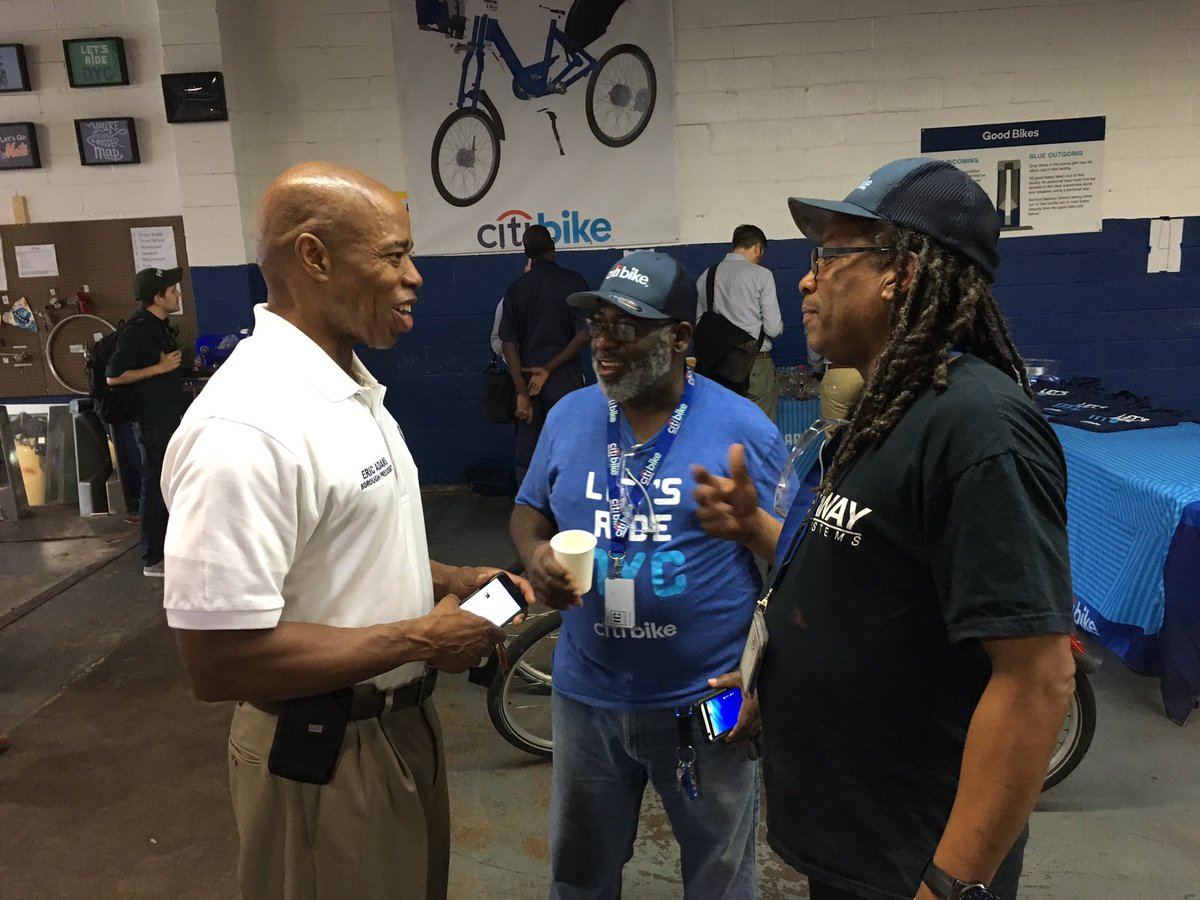
Brooklyn Borough President Eric Adams, left, the author (photo: @BPEricAdams)
It’s good to see our city engaged in a long-overdue discussion about safety on construction sites. “Safety first” is not mere sloganeering to me; nothing should top ensuring the health and welfare of every man and woman on every worksite.
The City Council has tackled and passed a number of meaningful reforms in recent months, and there is certainly more to explore. However, New Yorkers have good reason to be concerned about a bill known as Intro. 1447, which would likely sideline many local workers of color and prevent growing minority- and women-owned business enterprises (M/WBEs) from succeeding in the construction industry.
An earlier draft of this legislation would have required apprenticeships for construction workers; the current version being considered by the Council would necessitate a training requirement well in excess of the existing federal minimum standard set by OSHA. Either of these proposals would essentially result in a union mandate. I support unions and I am a longtime union man, dating back to my 22 years of service in the NYPD. But as I have noted in the past, my union pride also carries with it a responsibility to speak out when I believe there is inequity of opportunity within the ranks of my brothers and sisters in labor. In the construction industry, this largely remains the case, with several exceptions such as Carpenters Local 926.
The reality is that while some important gains have been made, I see from my own experience that union construction sites continue to fall short in reflecting the diversity of New York City. Equally important, too many of the union workers on Brooklyn’s construction sites do not actually live in our borough, or any of the five boroughs.
While construction unions have promoted apprenticeships and additional skills training as both a path to safer worksites and a way to diversify their workforce, no independent data has been released that shows the linkages for these claims. There is still no evidence that these efforts are providing minority workers with a reliable road to long-term career advancement. While apprenticeship programs may become more diverse, the higher-paying jobs on actual union worksites still elude the minority workforce. Until that changes, we should remain wary of approving de facto union mandates on construction sites that could otherwise provide much-needed job opportunities for highly-qualified New Yorkers of color, especially those living in public housing seeking a path to the middle class.
When it comes to M/WBE contractors, Intro. 1447 would have a very damaging impact because of the extremely high cost of its arbitrary training mandate. As City Council members should know, M/WBEs in the construction industry are generally smaller and less established than their competitors. If costs were to skyrocket, many M/WBEs would likely be unable to afford the difference, making it virtually impossible to compete for the jobs they need to stay in business. We must avoid any outcome that bars these hardworking small business owners from getting a fair shot in our city.
There is a strong argument that a universal enforcement of OSHA training certification requirements would be just as effective, and in some cases more so. We have seen that projects following strict standards on OSHA training — whether they be union or non-union — maintain safer sites and have fewer injuries. This would be a substantive step forward for safety.
I have sought to reframe the union construction conversation around the idea of job creation for all. It is only worth fighting for higher construction wages and good jobs when we ensure that all workers, including those who continue to fall through the inequality gap, are sharing equally in those victories. Now we also need to do the same thing for construction safety. There is no question that we need to make worksites safer, but it must be safer for all workers — and that means we must have an industry in which workers of all backgrounds have equal opportunity to participate and prosper.
***
Eric L. Adams is the Brooklyn borough president. On Twitter @BPEricAdams.
***
Have an op-ed idea or submission for Gotham Gazette? Email This email address is being protected from spambots. You need JavaScript enabled to view it.




